Samantha Fanshawe, the President of the Four Deserts Ultra Marathon Race and Corrado Giambalvo, a Technical Representative at Vibram FiveFingers in Italy, are both in town this weekend. And they shared some tips about running, to Active SG members last night, at the Singapore Sports Hub.
This talk, co-organised by Active SG and Train Live Compete (TLC) was held in conjunction with the inaugural Running Convention Singapore, which takes place today and tomorrow, at the Suntec City Convention Centre.
Fanshawe, an avid ultra runner, told runners how to get started with your first marathon, improving your marathon performance as well as transitioning into ultra marathons.
Giambalvo shared some tips on how to get started in barefoot running. Subsequently, his talk was followed by a practical and drills session. As well, runners also got the chance to experience barefoot running.
Samantha Fanshawe: Running Marathons and Ultra Marathons
Running your first marathon
When tackling their first marathon, Fanshawe advises runners to not simply follow online training programmes blindly. Rather, she feels that it is better to tailor these according to your individual needs, because after all, everyone’s goals for a marathon is different, and some people may have more time to train than others, depending on work and family commitments.
So it is better to plan your goals around what suits you. For example, if you have a late night work conference every Wednesday, it is not advisable to plan a 20km run on Wednesday nights.
Types of training techniques for a marathon
Fanshawe says that there are many types of training techniques available to runners. For example, these include long runs, versus short speed work, interval training and hills training.
For example, short runs with speed work typically involve incorporating short sprints during the course of an average run, for example, doing 100m bursts every kilometre, during a 5km run.
Hill training, especially sprinting up hills, is also good, as it helps to strengthen the body, and after a period of hills training, it will become a lot easier to run on flat ground and gentle slopes, so you will end up going much faster. However, Fanshawe admits that hills aren’t easy to find in Singapore – and that perhaps Mount Faber is your best bet for hilly terrain here.
Cross training is also good for runners, especially road marathoners who are spending many hours pounding hard tarmac pavements. Running on hard pavements cause wear and tear to the knee joints, so doing activities other than running, such as spin classes, swimming or boot camps, will give the knees and running muscles a break, and help to build up one’s fitness in other ways.
Training for a marathon
Fanshawe points out that setting a starting date for your training to begin is the most important thing, because if you don’t have a concrete date, then you will most likely keep on postponing the training. As well, having a per week or per month target in terms of mileage is important in order to consistently keep on improving.
But at the same time, she added that you should not force yourself to train if you are feeling sick – and don’t double your training the following week after recovering from an illness.
While some people believe in clocking no more than 30km to 32km on a single long run when training for a marathon, Fanshawe says that she is an advocate of running the full distance. “That’s because if I have never done it, I will start to doubt myself,” she explained.
During your training though, it is important to have key milestones, such as setting out to complete a 5km run or a 21km run within a set timing, to ensure that your training is on target. These runs can be actual races or personal time trials.
As for tapering for a marathon, Fanshawe feels that one week of tapering is enough. For the two to three days before a marathon, she advises runners to do very gentle exercises, such as a light walk or a slow swim, but nothing too intense – just to get any excess energy out of the body and to prevent you from getting itchy to exercise.
During the marathon
On marathon race day, Fanshawe says that it is too late to worry about a missed training session – unless you have for example, missed out on every single long run scheduled.
For pacing, it is important to have a respectable goal that is within your abilities. For example, do not aim to run a 3-hour marathon on your first attempt, if you have been averaging a pace of 6.30 minutes/kilometre during your training sessions.
“And finally, just enjoy yourself and don’t stress yourself out. If you are having fun, you are more likely to meet your goals in the process of getting there,” Fanshawe added.
Improving your marathon time
Fanshawe advise runners to first take a look at their ideal race weight. “Most runners may look fit, but if you are even 1kg or 2kg over your ideal weight, it will slow you down when doing endurance running,” she explained. There are resources online in order to do so.
As well, you should also set goals for your training. For example, tell yourself to do a 5km run in 25 minutes, or 30 minutes of speed work. However make sure that your goals are achievable and do not expect instant returns – you will only see results after about a month or more of consistent training.
Also, adding new elements to your training will help you to improve. For example, if you did not do any yoga when training for your first marathon, it may be good to pick this up as yoga is known to help make the limbs subtle and increase flexibility. As well, consistently adding new elements help to prevent injuries because it will work out different muscle groups while other muscles will be given a break.
Fanshawe added that you should do the complete distance or more during some of the training sessions, but at a slower pace – because she feels that this will make the race itself feel a lot easier in comparison. For example, if you are targeting a 2-hour half marathon (21km) on race day, perhaps you can aim to do a 21km training session in 2:30 hours.
Ultra Marathons
Besides giving tips for running marathons, Fanshawe also shared with the Active SG members last night, on running ultra marathons and why runners should consider this type of lifestyle.
Anything over 42.195km is typically defined as an ultra marathon. However, some standard distances for ultras include 50km, 100km, 100 miles as well as multi-stage races of 250km and above.
Why do an ultra?
Compared to a marathon, an ultra provides more variety for the body and mind in terms of scenery and terrain. Fanshawe said, “Instead of pounding pavements all the time, you are going from trails to roads and it helps to prolong your running career due to the varieties in terrain. While the New York and London marathons are amazing in terms of crowd support and overall experience, it is still the same type of thing. Also, you can run marathons while doing ultras, but treat them as part of your training, and not the end goal.”
Training for an ultra
Fanshawe points out that while an ultra can seem quite intimidating compared to a marathon, it is possible to train for it. “Everything during training will be a bit longer. Your short as well as long runs should be longer and spending more time on your feet is important. For example, you can go out on 40km to 50km overnight runs at nights after work to get your body used to running without sleep and fatigue.”
Also, Fanshawe added that it is important to bring hydration and food during an ultra. It may be possible to get away with it during a marathon and simply rely on the aid stations at the race, but it is impossible to do this for an ultra because they can sometimes be quite far apart. “And once you are low on food and calories, it can be hard to catch up. You need to think and listen to your body more,” she added.
It is also important to train on a variety of terrains for an ultra, and not simply on roads all the time. “You should run on trails and fields, as well as roads. Beach running also strengthens the legs in different ways, so that may be useful for ultra running too,” Fanshawe added.
Corrado Giambalvo: Minimalist & Barefoot Running
According to Giambalvo, a Technical Representative at Vibram FiveFingers as well as a coach with the Italian Track and Field Federation, minimalist and barefoot running may not be suitable for everybody as everybody has different preferences and ideals. But like most things in life, he feels that if you don’t try it, you will never know whether you will like it.
In third-world countries, such as those in Africa, many of the people are too poor to afford running shoes. Yet they have some of the world’s best distance runners. Said Giambalvo, “We are born with our feet and not with shoes. People in Africa are running and walking sometimes up to 30km per day without shoes, to school, since they were very young.” So to them, barefoot running is completely natural and so they have very strong legs and feet to conquer the world of distance running.
Barefoot Running & Minimalist shoes
Unlike normal running shoes which may be very thick, barefoot running and training with minimalist shoes will enable you to feel the full range of movement in your feet. At the same time, it adapts and strengthens the leg and feet muscles and helps you to get in touch with your running cadence, stride length and intensity.
Transitioning to barefoot running
Giambalvo advises runners to take it gradually, if you wish to transition from training with normal shoes to doing barefoot running. Do not suddenly go all out and do a 20km barefoot run if you are not used to it. Instead, he advises you to do perhaps a 1km or 2km barefoot walk/run around your block at the very beginning, just to see if you like it. And then slowly and gradually increase the distance.
At the same time, Giambalvo says that you should bring your running shoes with you, just in case you don’t like barefoot running and want to go back to what you are comfortable with. “Accepting challenges is one thing, but you also need to know how to get out of the challenge if you don’t like it. It’s like experimental learning and adapting by trial-on-error, but feel free to go back if you don’t like something new,” he explained.
Practical Session with Giambalvo
After the theory talk, Giambalvo brought runners out on a short 888m run around the Singapore Sports Hub’s 100 Plus Promenade. During this session, we learnt about running cadence, stride length and intensity and how to incorporate these into running. Participants were also given the opportunity to take off their shoes if they wanted, but this was not compulsory though. I found the short session very interesting and I felt that I learnt a lot about running from this.
While Giambalvo’s session was taking place, runners were also given a choice to opt for a practical running session with Fanshawe. This was a simple short run around the Singapore Sports Hub.
Other Blog Posts
- Running Tips from Soh Rui Yong
- Running Tips from Mok Ying Ren
- Mok Ying Ren’s Run to Walk Group at Bedok Reservoir
- How Soh Rui Yong became the second fastest Singaporean marathoner ever

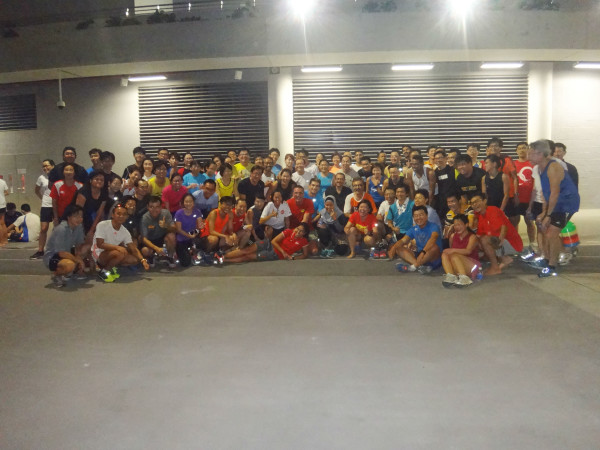
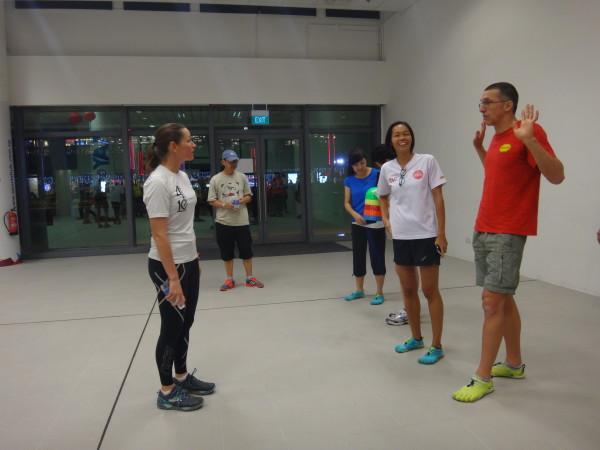
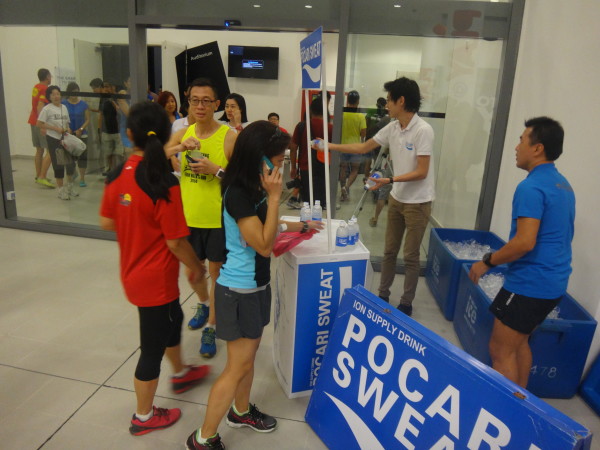
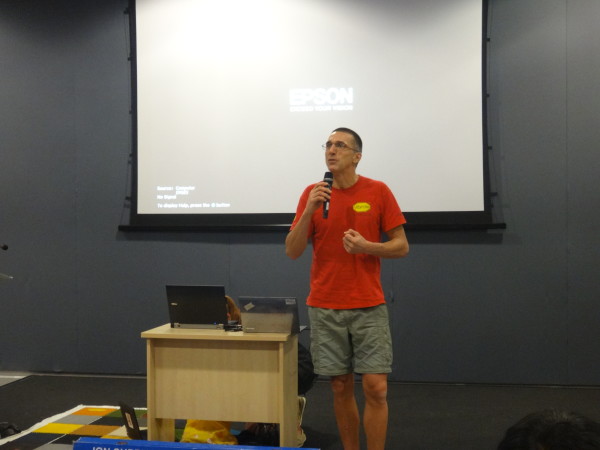
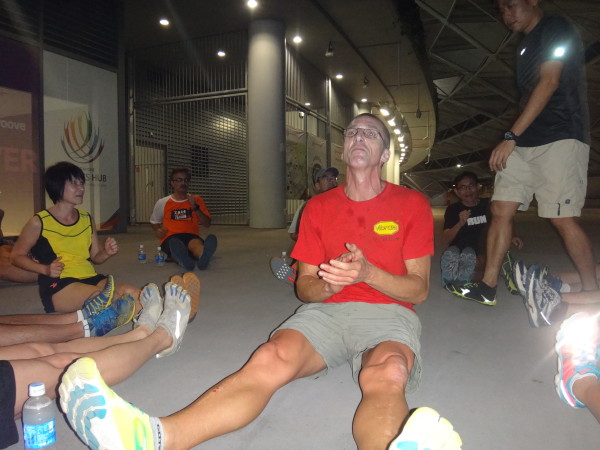
Leave a Comment